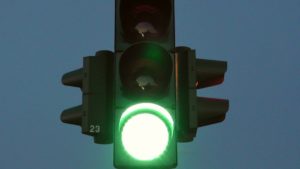Justice Department Will Intervene in Disability Discrimination Suit About Pedestrian Safety
by Beth
 I just got word that the U.S. Department of Justice has moved to intervene in a disability discrimination lawsuit brought by private plaintiffs alleging the City of Chicago violates the Americans with Disabilities Act (ADA) and Section 504 of the Rehabilitation Act of 1973 by failing to provide accessible street-crossing signal information for pedestrians with disabilities.
I just got word that the U.S. Department of Justice has moved to intervene in a disability discrimination lawsuit brought by private plaintiffs alleging the City of Chicago violates the Americans with Disabilities Act (ADA) and Section 504 of the Rehabilitation Act of 1973 by failing to provide accessible street-crossing signal information for pedestrians with disabilities.
Chicago currently provides visual crossing signals — “walk/don’t walk” signs and countdown timers — for sighted pedestrians at nearly 2,700 intersections. It has only installed Accessible Pedestrian Signals (APS) at a mere 15 city intersections.
Sighted pedestrians use flashing “Walk/Don’t Walk” signs and countdown timers to alert them when it is safe to cross the street. I can’t see those helpful devices. Devices providing pedestrians with safe-crossing information through audible tones, speech messages, and vibrotactile surfaces do exist, but too few of the busy intersections in Chicago offer them. The proposed suit alleges that the lack of accessible pedestrian signals at over 99 percent of Chicago’s signalized intersections subjects people who are blind, have low vision, or are deaf-blind to added risks and burdens not faced by sighted pedestrians, including fear of injury or death.
I’ve come across accessible pedestrian signals in other cities we’ve visited — Madison, Wisconsin comes to mind, and Urbana, Illinois has a few — but those were inconsistent. At some intersections, hearing “beep, beep, beep” meant I should cross, and at others it meant I should stay put. Looking for the button to press to activate the accessible pedestrian signals got me off-track and made it hard to find the crosswalk again. Sometimes the beep, beep beep noise was so loud it made it difficult to hear and judge the traffic surge. I pitied the poor people who lived and worked near one of the APS and had to hear it all the time.
When I was newly blind and learning to use a white cane, orientation and mobility (O&M) instructors taught me to rely on the surge of traffic at my parallel to recognize when the signal is green and it’s safe to walk. That principle is reinforced every time I travel to Morristown, New Jersey to train with a new Seeing Eye dog. In fact, at the Seeing Eye, one isn’t eligible to be matched with a dog without having completed O&M training.
Dogs are color blind. Seeing Eye dogs can’t read the stoplights, so it’s not their job to determine when it’s safe to cross a busy street. They are trained to go right up to every curb at each street crossing they get to, stop right there, and trust their human partner to use their sense of hearing to figure out what direction traffic is moving. Once we’re certain that traffic is flowing the same direction we want to travel, we give our dogs the command to cross. Dogs are trained to keep an eye out and to disobey their partner if the team is in harm’s way. It’s called intelligent disobedience, and it’s a pretty difficult thing to ask the dogs to do, when you think about it.
Traffic in Chicago has changed immensely in the year my new Seeing Eye dog Luna has been with me — things started out normal in February, 2020. Then came the COVID shutdowns in March. Cars were few and far between, making it difficult to rely on my sense of sound to judge traffic flow. “Is the light green?” With so few people out and about, there was no one to ask.
Traffic increased again when things opened up in the summer, then decreased again when a surge in COVID forced another shutdown in fall. I’ve made my share of bad decisions at intersections during these times, and I cringe to think that onlookers are blaming my young new dog Luna when it’s me who made the mistake.
So I’m no longer skeptical when it comes to accessible pedestrian signals. Do I need one at every corner? No. Be selective and put them at particularly difficult intersections — the T-intersection down the street comes to mind. I need all the help I can get at that one. You know what else would help? Making the already-existing countdown timers audible. In these times of talking computers, VoiceOver on smartphones, and speech synthesizers, it seems a simple call-out of “ten, nine, eight…” and so on wouldn’t be that difficult. And what a great help it would be to me and my fellow visually-impaired pedestrians.







May 7th, 2021 at 9:53 pm
Hate it the fuck-+Lovespeech